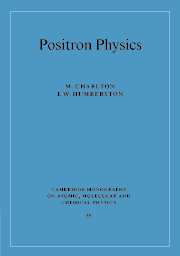Book contents
8 - Exotic species involving positrons
Published online by Cambridge University Press: 15 August 2009
Summary
We now consider several of the more exotic systems in which one or more positrons may be involved, some of which were introduced in subsection 1.2.3. The positronium negative ion (e–e+e–), Ps–, has been observed in the laboratory (Mills, 1981) and its lifetime against annihilation determined experimentally (Mills, 1983b). We discuss these experiments and the relevant theory in section 8.1. Observation of the positronium molecule, Ps2, and other systems containing more than one positron or positronium atom (as yet unrealized) depends upon the generation of large instantaneous densities of positrons. The situation here is more encouraging than might be expected, owing to progress in developing very intense brightness-enhanced and time-focussed beams, as summarized in subsection 1.4.4. Many-positron systems and how they may be observed are described in section 8.2.
Antihydrogen, as discussed in subsection 1.2.3, has recently been observed in the laboratory, although only at relativistic speeds. However, progress with the trapping of cold antiprotons and positrons, and the production of positronium in a cryogenic environment, leads us to anticipate the synthesis of antihydrogen atoms with very low kinetic energies (or temperatures); thus it may be possible to trap them, and perform precision spectroscopy upon them. The motivation for the production of low temperature antihydrogen is described in section 8.3, along with the mechanisms and methodologies involved in some of the proposed formation processes.
- Type
- Chapter
- Information
- Positron Physics , pp. 362 - 388Publisher: Cambridge University PressPrint publication year: 2000

